City trip Kraków
A visit to the old city is a treat
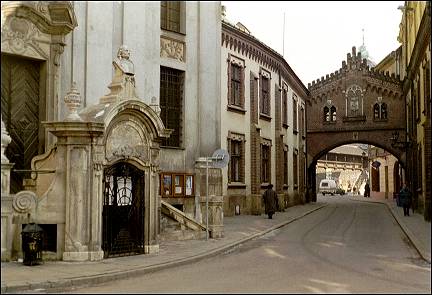
|
Countless medieval and Renaissance buildings dominate the old city of Kraków inside the old city walls. Around the central square with the Clothmakers Hall are churches and bars. The Wawel fortress, with its royal castle and cathedral, is the historical heart of Poland. In Kazimierz are synagogues and the old university.
Travelogue: Sandra van Berlo
Photos: Michel van Berlo & Sandra van Berlo
When we enter Poland by bus around 6 AM, the sun just rises. An orange glow illuminates the snowy landscape. It will take another 10 hours to reach our destination Kraków driving on Polish provincial roads.
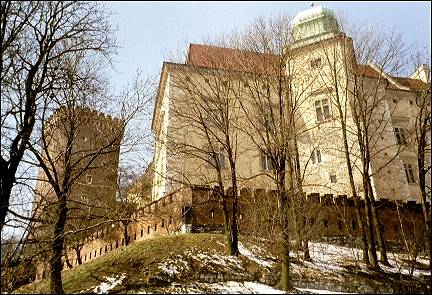
|
During the drive to Kraków we get acquainted with the only other foreigner on the bus. Mike, an American, works in Kraków as a volunteer for the Peace Corps. He offers to take us to our hotel: he knows Kraków well by now.
The other passengers are Poles who are on their way back from Holland, where they work every now and then. We get off in the bus station which is behind the train station of Kraków. Via an underpass we reach the city park Planty, which surrounds the old city center. Here were the city walls and moat.
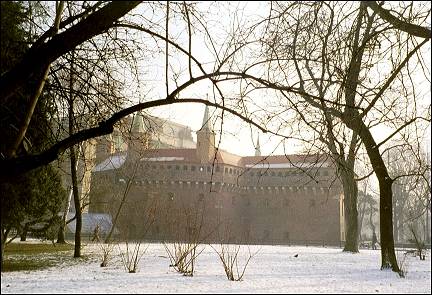
|
It is a 4 kilometers walk around the city center through the park. Even now, while it's rather cold, lots of people are enjoying the park. Mothers are taking a walk with their children, elderly people sit on benches, chatting, and people who work in the center eat their lunchtime sandwiches here.
Everything inside the circle formed by the park is called Stare Miasto, the old city. Most of it is a pedestrian area. In the ring around it, only a limited amount of cars is allowed for bringing supplies to stores and to drop tourists at hotels. Around that part is a zone where one can park for a maximum of 2 hours. All of this makes a visit to the old city a treat.
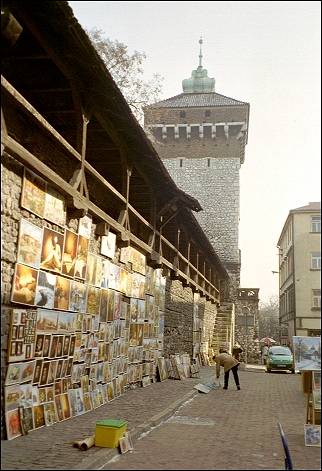
|
From the Planty you can enter the old city at a few entrance points.
The prettiest route uses the Florian Gate, one of seven gates in the defense wall that was built between the 13th and 15th centuries.
Before entering the gate, one sees the Barbacane, one of Europe's last round bastions. Its 3 meters thick walls were in the past connected to the gate by a tunnel.
Just past the Florian gate is the Painters Wall, where Art School students sell "three penny paintings." On the corner is a McDonalds, housed in a fabulous historic building.
The Florian gate leads to Florianskastreet, the historical entrance to the old city.
On this street are some Renaissance buildings, of which one can be visited. It houses the famous café Jama Michalika, where during the interbellum wild nights with cabaret Zielony Balonik (The Green Balloon) took place. It also is the first bar where a woman dared to light a cigaret. In the entrance to the bar is a glass case with hand-made X-mas tree decorations: they cost between 38 and 72 zloti.
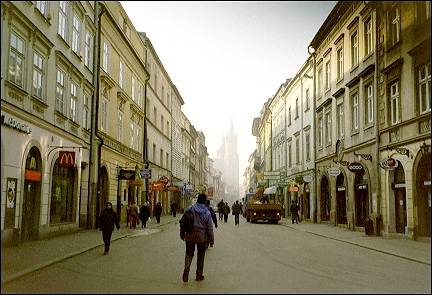
|
Florianskastreet always was the commercial street and now that tourism is developing, one after another (expensive) boutique opens here.
Rynek Glowny
At the center of the medieval square is the Clothesmakers Hall
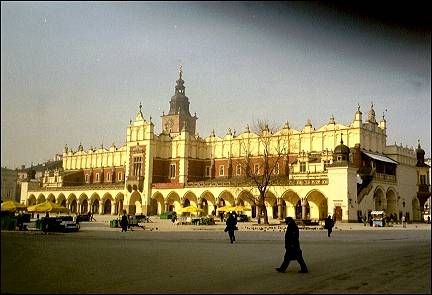
|
Floranskastreet ends on the central square of the old city, Rynek Glowny: a stunning medieval square, twohundred meters long and wide.
At the center of the square is the Clothmakers Hall, Sukiennice: a symmetrical yellow building with beautiful arcades and vaults under which are stalls with glass, jewelry made of amber and silver, wood carvings and traditional clothes.
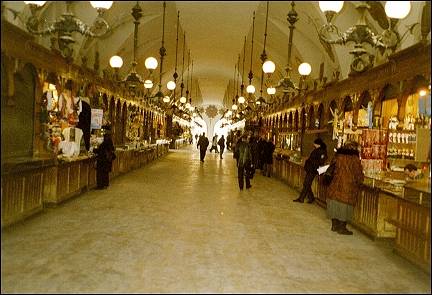
|
The original Clothmakers Hall was built in the 13th century. After a fire in 1555 it was rebuilt in Renaissance style and the arcade was added only in the 19th century. On the upper floor, the building houses an exhibition of Polish painting on lend by the Naradowe Museum. Most paintings are 19t century.
Because both the square and the Clothmakers Hall are symmetrical, you get easily disoriented the first time you're there: you don't know where you came from and have no idea what your position is vis a vis the streets that end on the square. The Trotter guide even warns never to meet anyone on a terrace here: there's a 50 percent chance that you'll be waiting on a terrace on the wrong side of the square.
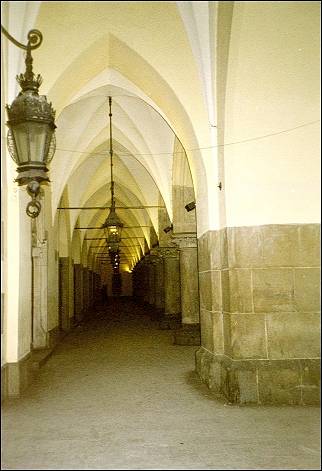
|
Luckily the square has sufficient points of orientation if you look a little longer, like the Maria Church. One of its towers used to be a watchtower; every hour you hear a four notes melody, played on a trumpet. Legend has it that in 1241 a sentry sounded the alarm with his trumpet when the Tartars approached. But already after four notes an arrow pierced his throat and the sentry fell down dead.
The towers of the Maria Church aren't equally high. Legend has it that two brothers competed who could build the highest tower in the shortest amount of time. The good brother seemed to be winning and the bad one killed him with a knife out of jealousy. Then he killed himself as well. The towers were left the way they were.
The church is not so much interesting on the outside. It is famous for its altarpiece by Wit Stwosz (Veit Stross). It is completely made of wood and one of the largest altarpieces in Europe. As soon as the enormous side panels open (every day exactly at noon), a scene becomes visible. In the central panel Mary is dying amidst the apostles. The altarpiece shows how the different ranks in medieval society dressed and what kind of weapons, furniture and pottery they used.
The altarpiece is painted blue and partly covered with gold paint, which makes it both tense and serene. On the blue ceiling gold stars are painted. It is as if you're watching an unclouded sky with stars on a beautiful summer evening. The 14th century stained glass windows reinforce the colors. The walls are painted different shades of red.
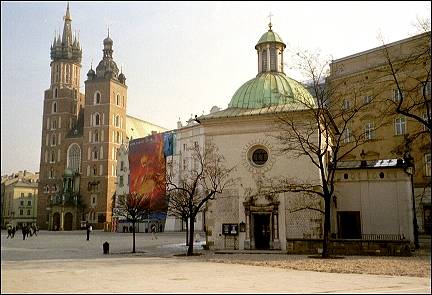
|
On the Rynek Glowny is also the Adalbert Church: the oldest historical building in Romanesque style in Kraków. In the church is an exhibition about the history of the market on the Rynek.
On the other side of the square is the town hall tower, the only remaining part of the 13th century town hall. The tower houses the theater café Maskaron and upstairs is a museum with some historical photographs of the city, but the climb is mainly worthwhile because of the view.
The square is, even at a temperature of minus 5 degrees Centigrade, lively at every time of the day: there are flower stalls, musicians, souvenir sellers, church visitors in the daytime and young people at night. In the summer it's probably crowded, with lots of terraces. It looks as if there is a lot of promenading during the summer.
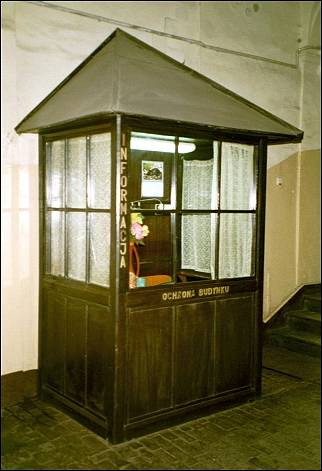
|
Around the square are gorgeous, centuries-old patrician houses. Behind the old exteriors are all types of stores, from fancy glass stores and restaurants to modern internet cafés and the ubiquitous Pizza Hut. Everything has been adapted to the style of the square and nothing looks too out of place.
Behind the exteriors are also courtyards with porter's lodges and vaulted bars. It's pleasant to take a break and visit one of the many "Kawinariaas" (coffeehouses) or to end the day with a large glass of beer in one of the many basement bars around the square. The music and the interiors of these places exude a relaxed 1970s atmosphere.
A little farther in the city center is the 15th century Church of the Holy Cross, which can only be visited during services. The church is special because of its modest interior.
Wawel fortress
Here the Polish dukes and kings ruled over their empire
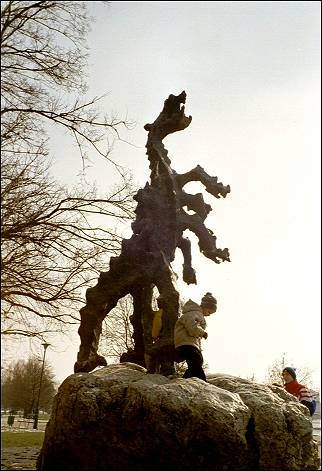
|
At the foot of the Wawel hill sits a big bronze dragon. According to legend, in the past a dragon lived in a cave underneath the hill. It had to be fed cattle every week to keep it from eating people. King Krak, who ruled over Kraków, promised his daughter and the throne to anyone who would kill the dragon.
The brave shoemaker Skuba stuffed a lamb skin with sulphur and left it in front of the cave. The dragon ate the meal and soon the city and the castle trembled because of the beast's roaring. The monster crawled to the river and drank until it exploded. After the death of the dragon there was a huge wedding party in the castle for the princess and the smart shoemaker.
When we enter the Wawel hill through the Waza Gate (1595), an elderly man approaches us, asking if we need a guide. As we have enough information, we don't need his services. When he hears where we come from, he spontaneously names Dutch cities like Amsterdam, Rotterdam, Utrecht, Breda and... Eysden (which is a small town and not very well known, Ed.).
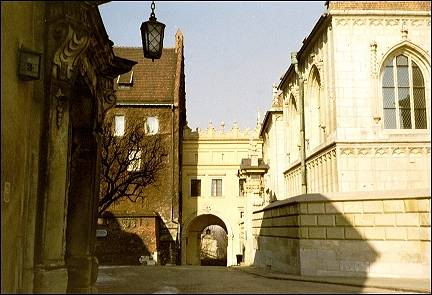
|
The Wawel hill with its beautiful buildings is the historical heart of Poland. Here Polish dukes and kings ruled their huge empire. The classical music that is playing helps to make you feel you're reliving the past. For a moment one imagines oneself the lord or lady of the castle.
Immediately to the left of the Waza Gate is the cathedral. Because of the limited space on the hill, it could not be expanded and the cathedral kept its Gothic architecture, even though it was embellished and surrounded by chapels in later periods.
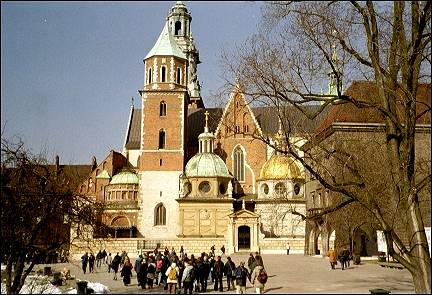
|
To the left of the massive entrance to the cathedral hangs a chain with bones of pre-historic animals. According to legend they are the bones of the dragon who terrorized the hill. They are supposed to have the power to avert evil and protect the cathedral.
They're not chicken bones: their size is really impressive and you wouldn't want to run into a living animal with bones like that.
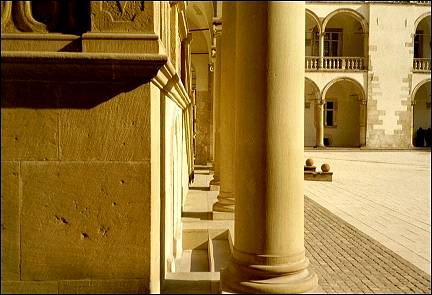
|
The prettiest of the chapels around the cathedral is the Zygmunt chapel, on the outside recognizable by its gilded cupola.
The chapel, built between 1519 and 1533 by the Italian architect Bartolommeo Berecci and commissioned by King Zygmunt I Stary (The Elder), is considered the most beautiful Renaissance construction north of the Alps.
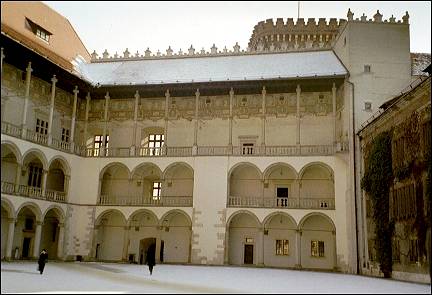
|
On the, according to Renaissance principles, cube-shaped space rests an octagonal box which supports the cupola. The chapel is decorated with arches, weapons and portraits of King Zygmunt as King Soloman and Alexander the Great.
On the Wawel hill is also the royal castle which was for almost six centuries the residence of Poland's rulers: from 1038 when King Kazimierz I Odnowiciel made Kraków the capital of Poland to the end of the 16th century when King Zygmunt III Waza moved the residence to Warsaw.
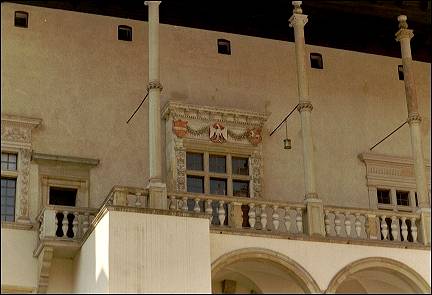
|
Via the long castle gate (with the inscription "If God is with us, who will be against us?") one reaches the famous Renaissance style courtyard built by Francesco Fiorentino in 1507.
On the ground floor were rooms for servants, the chancellery and the treasuries. The royal chambers are on the second and third floor along the gallery.
Jewish Kazimierz
The quarter was renovated after Schindlers List
From the Wawel hill it's not a long walk to Kazimierz. Originally it was an seperate city, founded in 1335. Decisive for the history of the city was King Jan Olbracht's decision in 1495 to house the important Jewish community there. The city was divided into a Christian and a Jewish part, separated by a wall. Jewish culture florished and permeated all of Kazimierz. By the end of the 16th century the city became part of Kraków.
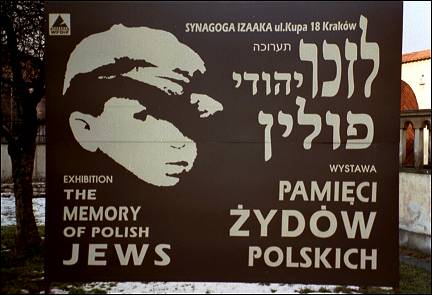
|
At the beginning of the second world war Kazimierz was - with Warsaw - the center of Jewish culture in Poland. Almost all of the 70.000 Jews, most of them extremely poor, who lived there before the war, were murdered in the gas chambers of nearby Auschwitz.
After the defeat of the Nazis the houses and synagogues were not rebuilt. It remained that way during the communist regime. Only in the 1990s - and even faster after Steven Spielberg filmed "Schindlers List" here - the Jewish quarter began to be rebuilt. The synagogues are renovated and can be visited. Kazimierz is outside the old city: there's a lot of traffic and you have to be careful not to get hit by a car or a streetcar.
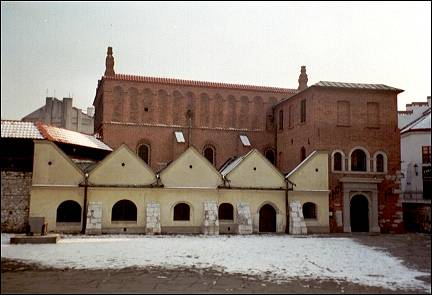
|
The most beautiful part of the Jewish quarter is Szerokastreet (Ulica Szeroka). This street, which is actually more like a square, is small and pastoral. It has a village atmosphere and you expect to see people play Jeu de Boules.
Around Szerokastreet are many sights. First there is the Old Synagogue, built in 1407 or 1492). It is the largest of the eight synagogues in Kazimierz and the oldest remaining Jewish building in Poland. Inspired by the synagogues of Worms, Prague and Regensburg and after the fire which burned down the whole quarter in 1557, it was rebuilt in Renaissance style by the Florentine architect Mateo Gucci. Now it is a museum for the history and culture of Kraków's Jews.
At 16, Szerokastraat is the Popper synagogue, named after its architect, a powerful 17th century financier. The synagogue was destroyed by the Nazis and now it houses a youth club. The 16th century ritual bath ("mikvah") at nr. 6 is a restaurant now.
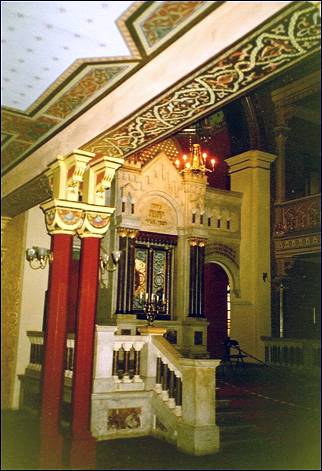
|
At the end of Szerokastreet is the Jordanow palace, also known as the Landau Palace. A rich family used to live here, now it is a bookstore, well stocked with studies of Polish Jewry.
Next to the bookstore is a restaurant where you can have a coffee in the daytime. It has the atmosphere of an old-fashioned living room: crocheted doilies, old sofas, an old dresser. Really worthwile. In the evening there's dinner, accompanied by live Klezmer music.
Accross the street is the Remuh Synagogue, founded in 1552 by, and named after, the famous Rabbi Moses Isserles. It is the only synagogue that is still in use by the few hundred, mostly elderly, surviving Jews in Kraków. Its founder still is an authority for Ashkenazi Jews in matters of Halakha (Jewish Law). He is buried in the Renaissance style cemetery which surrounds the synagogue.
Nearby in Miodowastreet (Ulica Miodowa), is the Tempel synagogue, a beautiful Classical Revival building (1869), founded by the organization of progressive Jews. The synagogue has a gorgeous circular colonnade and pretty stained glass windows, which were restored in 1970. An old man lets us in and allows us to take our time to see the interior. I think he is proud of the building.
Almost straight opposite it is the simple Kupa synagogue, founded in the first half of the 17th century. In the Izaaka synagogue, in the same area, is an exhibition about the history of the Jews in Poland.
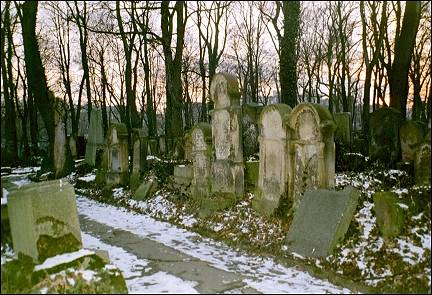
|
On Miodowastreet we visit the second Jewish cemetary, which was opened after the small Remuh cemetary was full. Its vastness indicates the size of the former Jewish community in Kraków.
The atmosphere is quiet, despite the fact that it lies between two busy roads. The cemetary is supervised by a man in a kind of garden shed. The advanced state of neglect makes you remember the visit (traditional Jewish cemetaries are supposed to be left alone as much as possible, Ed.).
The visit to Jewish Kazimirz ends a few streets farther at Wolny square with its small 19th century indoor market.
Christian Kazimierz
Medieval Gothic university buildings
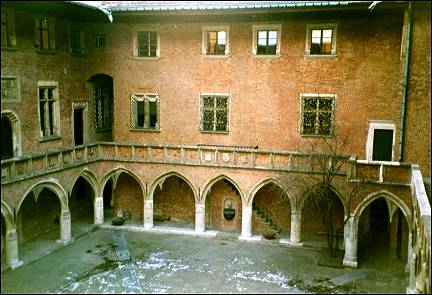
|
The center of the Christian part of Kazimierz is Wolnica square. Originally it was larger, but construction has taken up much of its space over time.
To the west of the square is a late 14th century town hall, which houses the ethnographic museum. On the square also sits the oldest church of the city, built in 1340 by Casimir the Great.
Kraków has a university quarter with many beautiful buildings. First there is the Collegium Maius, Poland's first university, founded in 1364 by King Kazimierz III Wielki. The building is considered one of the best examples of civic Gothic architecture. It also is one of the few remaining medieval university buildings.
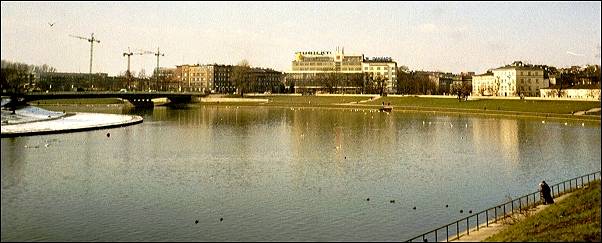
There also is the Jagiellonski University, built between 1883 and 1887. In the foyer on the ground floor are portraits of professors and other paintings that relate to the rich history of the university.
The salt mines of Wieliczka
Even the chandeliers in the cathedral are made of salt
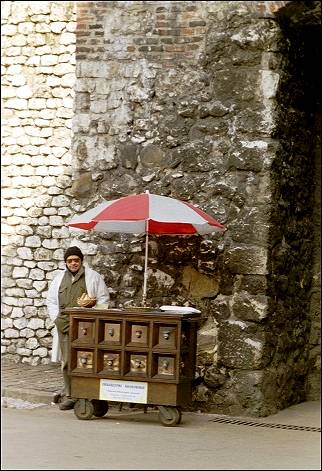
|
13 kilometers southeast of Kraków are the Wieliczka salt mines. You can get there by public transportation, but the local tourist office also offers organized trips by coach. We decide to do the last and leave at 9:30 AM with eight other tourists and a guide. Unfortunately taking pictures is not allowed in the mines.
At the mines we are welcomed by former miners who accompany the guides through the mine. The enormous salt mine is on Unesco's World Heritage list, with its 300 km of galleries on nine floors, a depth of 327 meters and a surface area of 10 square kilimeters. The mine is famous for its micro climate: two hundred meters beneath the surface is a sanatorium. Only the upper three floors are open to the public.
We climb down 200 steps to a depth of 135 meters. The galleries we're going to visit were dug between the 17th and 19th centuries. Former miners still make objects that are exhibited in the cave. The guide warns us that if you're claustrophobic, a tour of the mines may not be a good idea. During the tour she keeps joking about the risk of collapse and when at the end of the tour we take a diminutive elevator back up again, she says goodbye in case we won't meet again above ground.
This makes the tour of course even more exciting. Meanwhile, there is one surprise after another: we pass through halls and chapels with sculptures hewn from salt. The chapels were built so the catholic miners, who couldn't always go above ground, could practice their religion. But there are also Disney World types of tableaus and of course the beautiful salt cones that grow from the ceiling.
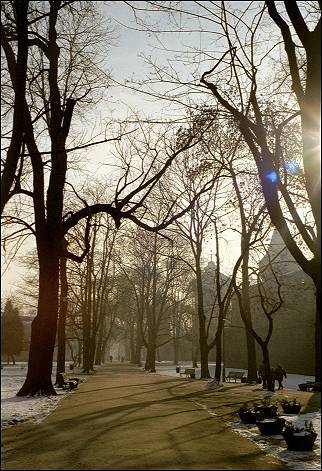
|
The highlight is a chapel dedicated to Queen Kinga (1224-1292). It is an underground cathedral, 54 meters long and 12 meters high, which took over thirty years to build. It's overwhelming: beautifully illuminated and shiny. Everything in the cathedral is made of salt, not just the altar and all statues, but even the floor tiles and the chandeliers.
The tour ends in a small historical museum which gives an overview of the history of Poland, just by pictures of the consecutive rulers. In the souvenir shop all kinds of objects made of salt are for sale.
We take the elevator up: exactly four people fit into it, there's no room to move. The elevator has just started to move up when it stops again in the dark of the shaft. People panic, until the guide explains that the elevator has two compartments and waits until people have boarded the lower compartment.
Auschwitz
It is advisable to visit the camp with a guide
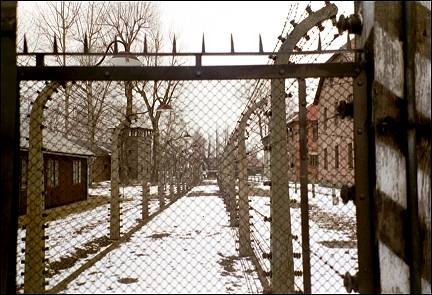
|
From Kraków there are day trips to the former concentration camp Auschwitz. Visitors are advised to visit with a guide. In Auschwitz the central camp can be visited as well as the second camp, Auschwitz-Birkenau.
The central camp is a museum. Several buildings have been converted to exhibition halls. The history of the camp is told with documents and photos of prisoners, personal belongings, etc.
The Auschwitz-Birkenau camp is completely in its original state. From the watchtower one has a view of the long rows of barracks.